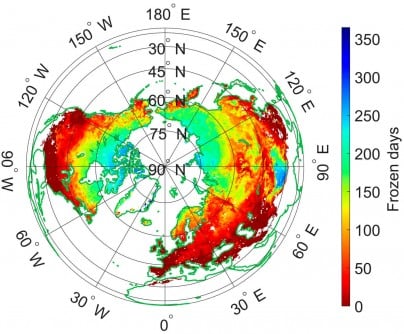Science
New Algorithm Enhances Soil Monitoring from Space Using L-Band Data

Researchers have made significant strides in soil monitoring by developing an advanced algorithm that enhances the detection of freeze-thaw (FT) transitions from space. Freeze-thaw cycles have a profound impact on weather patterns and hydrological cycles, as they alter surface albedo, moisture, and heat fluxes. However, previous methods struggled to accurately capture these dynamic processes due to limitations in existing large-scale models.
The innovative algorithm, developed collaboratively by researchers from Fudan University, the University of Twente, and the Chengdu University of Information Technology, utilizes L-band microwave remote sensing. This method is particularly effective because of its sensitivity to soil dielectric properties, as well as its ability to penetrate snow and vegetation. The findings were published in the Journal of Remote Sensing on September 10, 2025 (DOI: 10.34133/remotesensing.0806).
Enhancing Soil Freeze-Thaw Detection
Traditional algorithms based on the Soil Moisture Active Passive (SMAP) satellite data often rely on globally fixed parameters. This approach can lead to inaccuracies under diverse land cover and varying climate conditions. Addressing these challenges, the research team focused on creating a dynamic parameter optimization framework for soil freeze-thaw retrieval.
By improving the existing Diurnal Amplitude Variation–based Freeze–Thaw (DAV-FT) algorithm, the researchers introduced three dynamically optimized parameters—α, β, and γ. These represent the detection period, variance window, and threshold sensitivity, respectively. With a process similar to maximum likelihood estimation, these parameters are finely tuned to maximize overall classification accuracy across different regions.
The optimized algorithm successfully differentiates freezing and thawing states by analyzing annual variations in L-band brightness temperature as detected by SMAP. The results indicate that areas achieving an overall classification accuracy (OA) greater than 0.7 increased from 54.43% to 89.36%. The algorithm showed particularly strong performance in regions such as the Qinghai–Tibet Plateau, southwestern Eurasia, and southern North America.
Implications for Climate Monitoring
This new model has demonstrated high consistency with existing datasets, achieving an 81.28% match with ERA5-Land data and 79.54% with SMAP freeze-thaw data. Validation using 828 in situ soil temperature stations confirmed the algorithm’s superior accuracy, achieving a median accuracy of 0.92, outperforming both fixed-parameter models and previous SMAP products.
Dr. Shaoning Lv, the study’s corresponding author, emphasized the importance of this advancement: “The dynamic parameter optimization significantly enhances our ability to capture subtle soil freeze-thaw transitions that vary across regions and seasons.” He added that the method provides a more physically consistent understanding of land-atmosphere interactions, which is crucial for climate monitoring on a global scale.
The enhanced DAV-FT algorithm offers a robust framework for continuous soil freeze-thaw monitoring across various terrains, supporting climate modeling, agricultural management, and hydrological forecasting. Its capability to account for diurnal temperature cycles and regional heterogeneity makes it especially beneficial for high-latitude and mountainous regions, where existing algorithms are often ineffective.
By improving the accuracy of soil state detection from space, this method strengthens the foundation for assessing permafrost dynamics, water availability, and land-atmosphere energy fluxes—critical factors in predicting the impacts of climate change and enhancing global land-surface models.
The research was funded by the National Key R&D Program of China, the Key Research and Development Program of Inner Mongolia Autonomous Region, the Yan Liyuan–ENSKY Foundation Project, and the National Natural Science Foundation of China.
-

 Science3 weeks ago
Science3 weeks agoALMA Discovers Companion Orbiting Giant Red Star π 1 Gruis
-

 Top Stories2 months ago
Top Stories2 months agoNew ‘Star Trek: Voyager’ Game Demo Released, Players Test Limits
-

 Politics2 months ago
Politics2 months agoSEVENTEEN’s Mingyu Faces Backlash Over Alcohol Incident at Concert
-

 World2 months ago
World2 months agoGlobal Air Forces Ranked by Annual Defense Budgets in 2025
-

 World2 months ago
World2 months agoElectrification Challenges Demand Advanced Multiphysics Modeling
-

 World2 months ago
World2 months agoMass Production of F-35 Fighter Jet Drives Down Costs
-

 Business2 months ago
Business2 months agoGold Investment Surge: Top Mutual Funds and ETF Alternatives
-

 Science2 months ago
Science2 months agoTime Crystals Revolutionize Quantum Computing Potential
-

 Top Stories2 months ago
Top Stories2 months agoDirecTV to Launch AI-Driven Ads with User Likenesses in 2026
-

 Entertainment2 months ago
Entertainment2 months agoFreeport Art Gallery Transforms Waste into Creative Masterpieces
-

 Health2 months ago
Health2 months agoGavin Newsom Critiques Trump’s Health and National Guard Plans
-

 Lifestyle2 months ago
Lifestyle2 months agoDiscover Reese Witherspoon’s Chic Dining Room Style for Under $25









